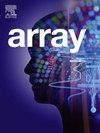Smart system for real time monitoring and diagnosis of dengue surfaces in Bangladesh
IF 2.3
Q2 COMPUTER SCIENCE, THEORY & METHODS
引用次数: 0
Abstract
Efficient vector management techniques hold great importance according to the World Health Organization (WHO) as a foundation to reduce and maintain the decline of vector-born diseases. Health surveillance teams operating in malaria and dengue and Zika and Chikungunya endemic areas can effectively use drone or unmanned aerial vehicles (UAVs) as technology to detect and eradicate mosquito breeding sites. UAVs enable users to obtain detailed aerial photographs and monitor locations throughout time and geographic areas. The process of vector control intervention analysis through manual image inspection requires extensive labor efforts and takes significant amounts of time. This research presents a methodology to automatically detect mosquito breeding areas in aerial drone images. Leveraging a CBAM-enhanced YOLOv9 object detection framework, we present a UAV-based strategy for dengue surface monitoring, achieving an impressive mean Average Precision (mAP) of 99.5% for mAP50, 86.4% for mAP50-95, 94% for Intersection over Union (IoU), 45 FPS, 98% precision, and 90% recall. The integration of the Convolutional Block Attention Module (CBAM) enhances the model’s feature extraction capabilities, improving its focus on critical regions in the images. Robust performance was ensured by the consistent achievement of these outcomes in a variety of operational and environmental contexts, including urban and rural locations. To confirm the model’s practicality, more tests under various circumstances will be carried out. This deep learning approach facilitates targeted and timely vector control interventions, leveraging drone-based surveillance to combat the spread of vector-borne diseases efficiently.
孟加拉国用于实时监测和诊断登革热表面的智能系统
根据世界卫生组织(世卫组织)的说法,有效的病媒管理技术非常重要,是减少和保持病媒传播疾病下降的基础。在疟疾、登革热、寨卡病毒和基孔肯雅热流行地区开展工作的卫生监测小组可以有效地利用无人机或无人驾驶飞行器(uav)作为检测和消灭蚊子滋生地点的技术。无人机使用户能够获得详细的航空照片,并监控整个时间和地理区域的位置。通过人工图像检查进行病媒控制干预分析的过程需要大量的劳动和大量的时间。提出了一种无人机图像中蚊虫孳生区域的自动检测方法。利用cam增强的YOLOv9目标检测框架,我们提出了一种基于无人机的登革热表面监测策略,mAP50的平均平均精度(mAP)为99.5%,mAP50-95为86.4%,交汇(IoU)为94%,FPS为45,精度为98%,召回率为90%。卷积块注意模块(CBAM)的集成增强了模型的特征提取能力,提高了模型对图像关键区域的关注。通过在各种业务和环境背景下(包括城市和农村地区)持续实现这些成果,确保了稳健的业绩。为了验证该模型的实用性,将进行更多不同情况下的测试。这种深度学习方法有助于有针对性和及时的病媒控制干预措施,利用基于无人机的监测有效地打击病媒传播疾病的传播。
本文章由计算机程序翻译,如有差异,请以英文原文为准。
求助全文
约1分钟内获得全文
求助全文

 求助内容:
求助内容: 应助结果提醒方式:
应助结果提醒方式:


